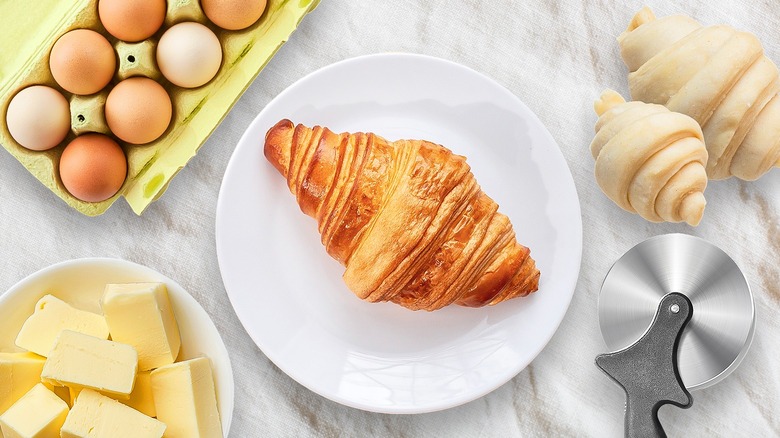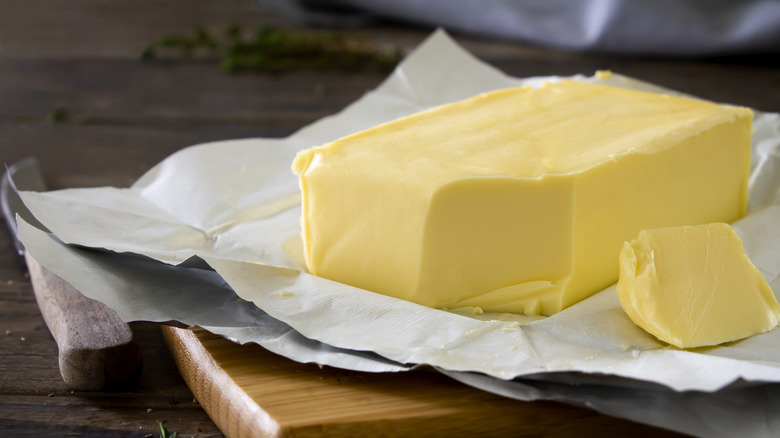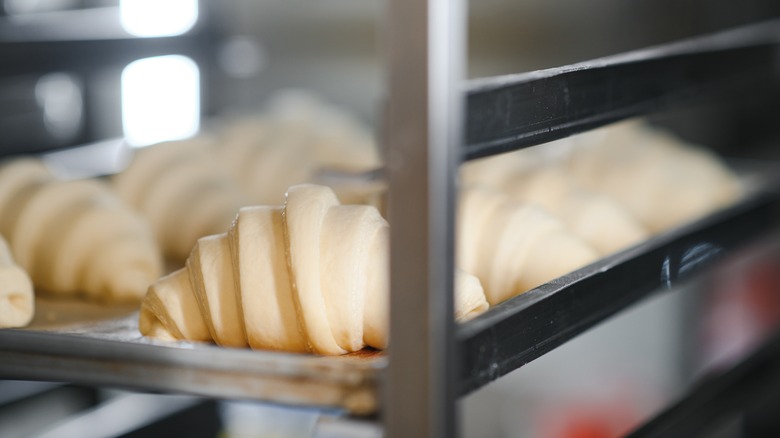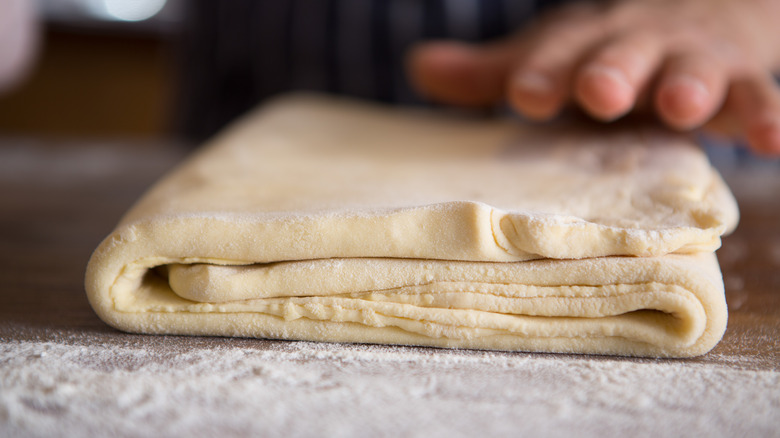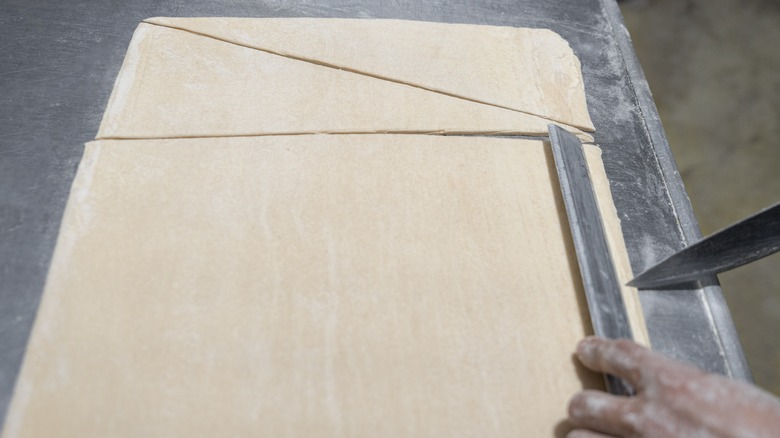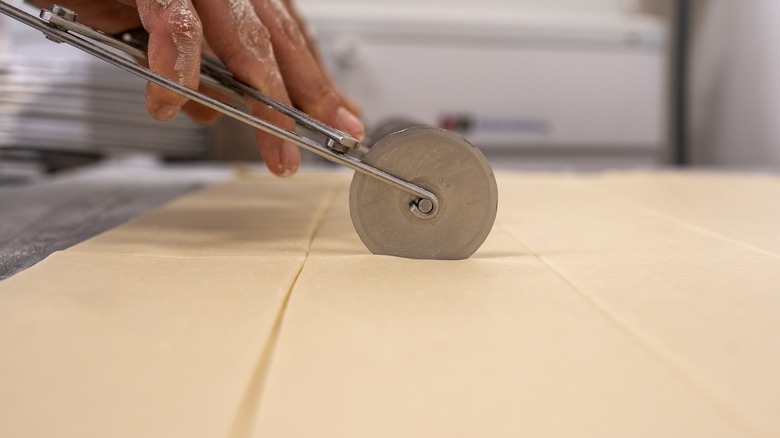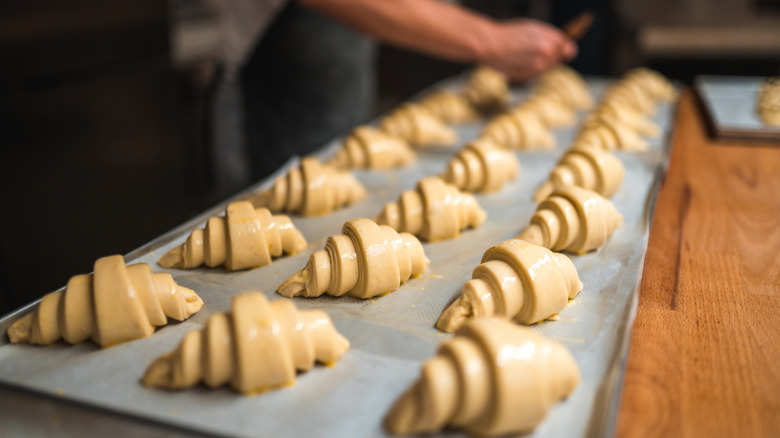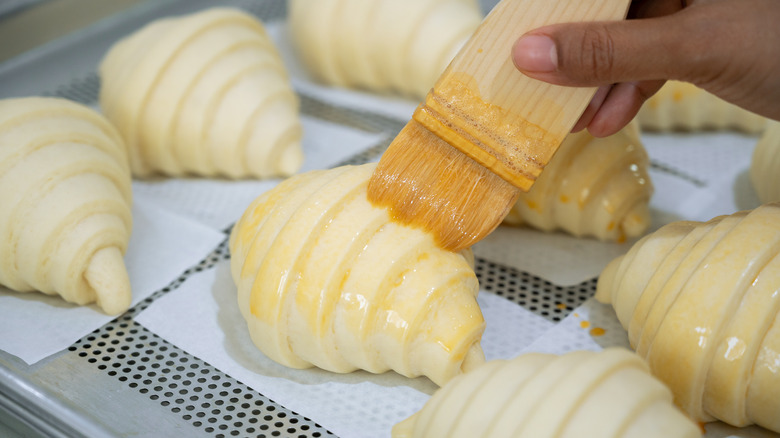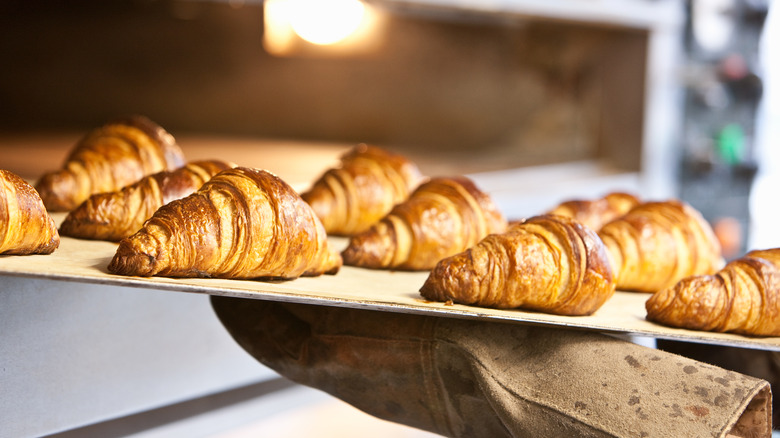8 Tips For Baking Homemade Croissants
Baking croissants from scratch can be intimidating, even for advanced cooks, but with practice, patience, and precision croissant success is possible at home. Croissants are the pinnacle of classic French baking made with a laminated yeast dough that's folded and shaped before baking. If executed properly, the end result is croissants that are full of buttery, flaky layers.
Croissant dough is made up of two components — the détrempe and the beurrage. The détrempe is the base dough and the beurrage is the chilled butter block that's folded into the détrempe. As a professionally trained chef and cooking instructor, I've worked extensively to understand the science and technique behind how these two components factor into making great homemade croissants. These are some of the tips I've learned to recommend.
The difficulty with croissants comes with combining the détrempe and beurrage carefully, without softening or melting the butter. The dough is folded multiple times to create the flaky layers, then chilled to set them in place. The goal is butter that is evenly distributed throughout the dough without being fully incorporated. This multi-step process can be challenging for beginning and expert bakers, but by mastering a few essential techniques and focusing on the details along the way, you can successfully bake croissants worthy of a Parisian boulangerie.
Choose the best butter
When you think about the most common croissant mistakes you might face when making them at home, you're right to worry about overworking your dough or baking the croissants at the wrong temperature. However, one step that occurs before you even start to mix your dough can have a huge impact on your croissant success. The first croissant-making tip to consider has to do with ingredients: Selecting the best butter is an essential choice that can make or break your croissants.
It's important to choose a high-quality butter, preferably a European-style butter for the best results. European butters contain a higher amount of butterfat, which will give your croissants a rich, buttery flavor. American butter typically contains 80% butterfat, and though European butters only contain slightly more, that small amount makes a big difference. Most European butters contain between 82% and 90%. French bakeries use butter with fat content in the range of 85% to 87%. Choosing a higher quality butter will make it easier to laminate, or layer, your dough, giving your croissants layer on top of delicious layer.
Keep it cold
Temperature is important all throughout the process of baking your croissants. You might be surprised to learn that the temperature of your ingredients, and the temperature of your croissant dough, both play a key role in whether your pastry bakes up light and airy or flat and dense. It's important to keep both parts of your croissant dough, the base dough and the butter block, chilled from start to finish of the creation process.
Unlike baking a cake or cookies where most recipes call for room temperature butter, croissant recipes call for cold butter. Cold butter is easier to work with and less likely to stick or tear, but the main reason why you need cold butter for croissants is texture.
Croissants get their layers from a combination of folding the dough repeatedly and the outcome of chilled bits of butter melting into those dough folds. When the cold dough is folded into the base dough, it stays solid, creating distinct layers instead of blending smoothly into the dough. When those bits of butter melt in the oven, then steam fills the tiny gaps they leave behind and lifts them to create flaky layers. If the butter gets too warm and melts prematurely — or is so soft it blends right into the base dough — your croissants won't have the lift and lightness you're looking for.
Rest and chill between turns
The turns required to make croissants from scratch refer to the process of rolling and folding the dough, usually into thirds. The dough is then turned 45 degrees and rolled and folded again. The folds help create layers in the croissant dough. Resting and chilling the dough between each fold is imperative for two key reasons.
First, allowing the dough to rest gives the gluten in the flour time to relax, which softens the dough, making it easier to work with. It also makes it easier to roll the dough to your desired thickness. Your croissant dough should be wrapped tightly in plastic wrap and placed in the fridge after each turn for 15 to 30 minutes. The longer you can rest your dough between turns, the better.
Resting the dough in the fridge also helps protect your butter block. Even as it's folded into the dough, it needs to remain solid and firm. Rolling it out and folding it can warm the butter up, causing it to soften and melt into the dough. Chilling between each turn cools the butter so that it remains solid.
Resting and chilling the dough between turns is a time commitment, as most croissant recipes require three turns before your dough can be shaped and baked. It will be well worth it when you bite into croissants that are crisp and airy.
Use a ruler
Precision is your friend when making homemade croissants. It's critical that your dough and your oven are at precisely the right temperature, and it's also imperative that you roll and shape your dough into croissants that are exactly the right size.
Using a ruler when it's time to roll out and shape your croissants will make sure you're getting it just right. If your dough is not the right thickness or not cut to the appropriate size your croissants will not bake properly. Professional looking croissants that are even in size and shape are possible, even for beginners, if you grab a ruler.
Most recipes list measurements for rolling out your dough to minimize waste and using a ruler will make sure you get it right. You can use the ruler to guide your knife as you cut the straight lines necessary for perfectly-formed croissants. You can also rely on a pastry ruler to measure your dough's thickness.
Grab your sharpest knife or pizza cutter
Once your dough's ready to shape into croissants the last thing you want to do is ruin the beautiful, flaky layers you've created in the dough with your turns, folds, and cold butter. The tool you choose to cut your dough may not come to mind when you think of ways to ruin your croissant dough, but using a knife that is dull can do just that.
When cutting your dough to shape it into a croissant, the goal is nice, clean cuts with no jagged edges. Using a sharp knife or pizza cutter to cut the dough is crucial for achieving those clean edges and preserving the well-defined layers in the final pastry. A dull blade will smash the dough, pressing it together and getting rid of the layers. Sharp blades will slice through the dough easily, without applying excess pressure or sawing back and forth. You'll get nice, clean edges and keep your layers intact.
Proof the dough after shaping the croissants
Making croissants from scratch takes patience. Between waiting for the dough to rise and resting it between turns, you might be tempted to pop your croissants right into the oven once you've shaped them. You may want to enjoy your croissants sooner rather than later, but allowing your dough to proof after your croissants are shaped is one tip you need to follow.
Proofing your dough before baking is essential for achieving the light, airy texture and rise that characterizes a perfect croissant. It's arguably the most important step in croissant making, because it's ultimately what jumpstarts the yeast. Without it, you'll end up with croissant-flavored flatbread instead of an actual croissant.
During proofing, the yeast ferments. The carbon dioxide this produces causes the dough to expand and puff up, which helps develop the layers created during the laminating process. It's what makes sure your croissants rise properly in the oven.
To proof your croissants, you need to place them in an area that's warm, but not too hot, between 75 to 78 degrees Fahrenheit. Your oven is the perfect proofing spot. Cover your croissants loosely with plastic wrap and place them in the oven until they've doubled in size. This could take more than two hours, so you'll need to practice your patience again.
Don't forget the egg wash
You can achieve bakery perfect croissants at home if you know the baking secret professional chefs use to create picture perfect pastries. It's all about the egg wash. Egg wash is made by beating an egg and using a pastry brush to spread it gently on the surface of your croissant. You can also add a splash of water or milk, but it's not necessary.
Lightly brushing your croissant dough with an egg wash will help them brown as they cook. It also gives croissants a glossy, golden-brown surface.
Croissants are typically brushed with egg wash twice. The first instance occurs immediately after the croissants are shaped, just before they're proofed. It helps keep the surface of the dough from drying out as the croissants proof. They're brushed again after proofing, just before you bake them. The two combined will give you the beautiful brown croissants of your dreams.
Get the oven temperature right
Once you've ushered your croissant dough through the time-consuming process of making it, the last thing you want to do is over or undercook them when it's time to bake. Baking them at the right temperature for ensuring they rise properly and develop their signature flaky texture. The ultimate goal is that your croissants have a crispy exterior and a light and tender center. Baking them at the wrong temperature can leave you with croissants that are either dense and under-baked or burnt on the outside with an undercooked center.
The standard temperature for baking croissants is 375 degrees Fahrenheit. It gives you the perfect balance of heat to make sure the inside is fully cooked and the outside browns properly. If your oven temperature is too low, the croissants won't brown or rise. A too hot oven will melt the butter too quickly and you'll wind up with a baking sheet of croissants in a pool of melted butter. An oven preheated to 375 degrees Fahrenheit will produce enough heat and steam to melt the butter at the appropriate rate and help separate the layers, giving the croissants their airy structure.
